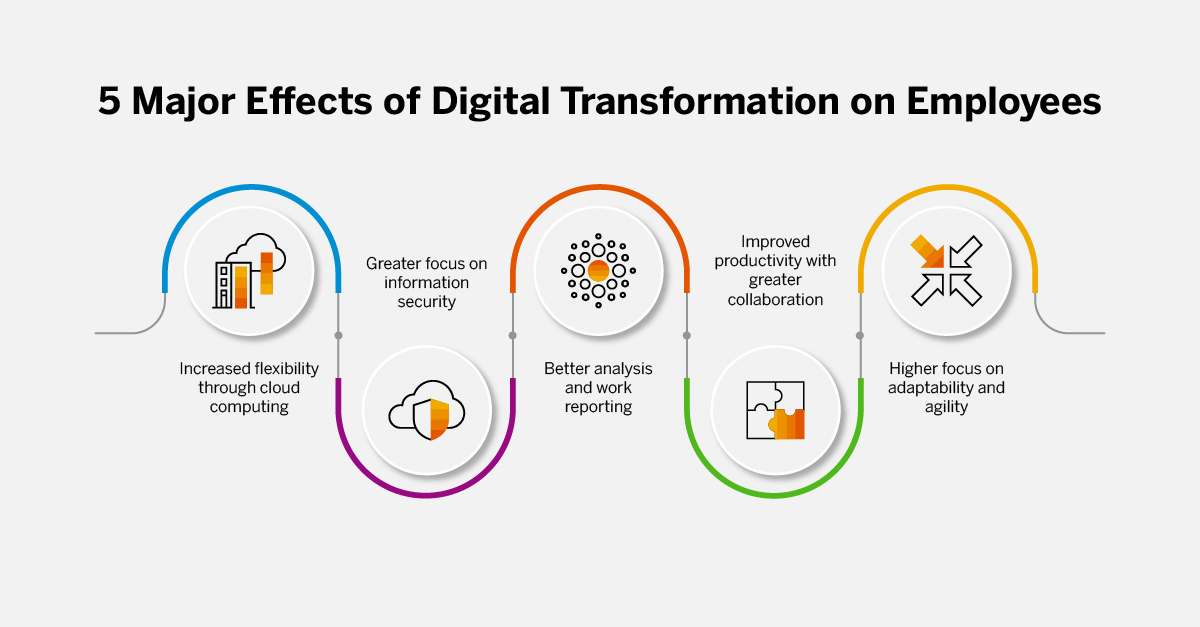The pandemic has changed how businesses operate and customer behavior, with everyone pivoting on digital. What would have taken years to achieve – digital adoption – took a year. The pandemic accelerated the timeframe and showed us the impending need to adapt to digital to be able to thrive in challenging situations. A digital transformation is no longer an option; it’s a means for survival.
Digital transformation in focus
Digital transformation is a paradigm shift, one that promotes experimentation and acknowledges failure. It generally refers to the integration of digital technology into all aspects of a business. It results in a fundamental change in the operation of the company and the way customers receive their services. Sometimes, long-standing business practices might have to be scrapped to usher in dynamically evolving work practices.
Digital transformation needs a problem statement that spurs the transformation and can mean different things to different companies. For one, it could mean going paperless. It could also mean the introduction of data analytics to another. But at its heart, it’s all about the work culture and leadership of the company.
In essence, the goal of digital transformation is to make a company future-ready. The development of operational and customer-oriented capabilities enables a company to be more agile. The use of data is a key point, so is participation in digital ecosystems. The major techniques employed include:
- Standardization, Automation, and core process re-use, through modularized services.
- Renewing and integration of digital infrastructure
- Seamless access of systems and data sources to company stakeholders (A single source of truth, similar to blockchains)
- Integration of customer offerings across multiple products and channels
- Collection of quality customer information which includes their needs, concerns, and goals.
- Creation of distinctive value propositions which make the company a customer’s first choice.
Customer centricity Drives Digital Transformation
Digital transformation is about customer-centricity. Today’s customers are looking for aspects such as personalized service, expanded self-service and more thought which enhances their experience.
Organizations need to give more focus to the customer’s journey. By incorporating customer satisfaction into the company’s corporate DNA, and by empowering the employee to deliver exceptional customer service through digital transformation, the company becomes intrinsically linked to the customer journey.
Digital Transformation should begin with a problem statement, an aspirational goal, or a clear opportunity, according to Quickrete CIO Jay Ferro. An aspirational statement could be about being the best to do business with through digital transformation. Or the ‘why’ part could be about improving customer experience, reducing friction, increasing productivity, and increasing profits. Companies are beginning to utilize technology to transform themselves to receive better insights into the customer journey. This crucial insight reduces friction, which increases the probability of them becoming recurring customers. Companies are also evolving themselves around these principles and reaping their rewards.
Being proactive and empowering the customers with self-service tools is one of the many ways to usher in digital transformation and improve the customer experience.
The Employee Experience (EX)
The Employee Experience is a holistic term used to encompass all aspects of how an employee thinks and feels during every touchpoint of their journey in an organization. It is an emerging business function that traces the employee journey and is a direct response to the Customer Experience (CX) function.
Since organizations now understand that satisfied employees make for satisfied customers, there’s an equal focus on EX and CX. The idea behind EX is for organizations to appeal to employees’ physical, intellectual, emotional, and aspirational wants and needs. While strategizing to improve the overall EX of a company, it is essential to hone on specific targets. There are three primary domains which include the Procedural Employee Experience, the Textural Employee Experience, and the Emotional Employee Experience.
Effects of Digital Transformation on Employees
- Increased Flexibility Through Cloud Computing
With the advent of cloud computing, employees have the freedom to do their work off-premises efficiently. And since remote working is a norm now, digital transformation is equipping employees with different means to work seamlessly. There is flexibility in the location of work, and employees reap the benefits of improved work-life balance. More than half of UK employees feel that they can be just as collaborative working from home as they can be in the office.

This flexibility is extended to hiring managers as well. They can now choose the person with the right skillset and do not have to compromise on candidates due to the location of the office or commute. Logistical challenges are reduced in the digital space, thanks to digital asset management and digital supply chain systems.
Cloud computing decreases redundancy and miscommunication among team members. Internal communications have never been so fluent, and employees are bombarded with myriad options to choose from. Social media, intranet, IM, team forums, and video conferencing are just a few of the many options available.
- Better analysis and Work Reporting
Human resources departments are now equipped with tools and digital dashboards to measure performance and monitor personnel activities thanks to the digital transformation of the workplace. Interactions and relationships between HR and business leadership have bloomed thanks to improved analysis and reporting technologies. Digital tools have a positive impact on workforce optimization and communication, which results in streamlined workflows, lower budgets, and quicker results. However, this comes at a cost to the personal privacy of the employees, and it’s a tight rope to walk on. Maintaining good performance and performance analysis techniques without going overboard is a challenge.
- Greater focus on Information Security
Digital adoption also creates information security risks that need to be managed through enhanced security infrastructure and processes. Anxiety around information security in today’s age is understandable, with data breaches becoming a common occurrence. But good leadership and management can avoid the pitfalls of information security by investing in good security infrastructure. It is important to prevent anxiety and cultural challenges in the workplace and instill confidence in the employees through good work practices. Information security is also the responsibility of employees, and this is a practice that should be a part of organizational culture. Employees should regularly be made aware of good information security practices, and the implications of not following them must also be made clear.
- Increased Productivity
Digitization of crucial business functions will ensure the employee spends time on the things that matter and does not waste time navigating labyrinthine workflows. Resources can be managed efficiently through digital systems that are accessible remotely. Collaboration becomes easier and good relationships can be built around the workplace, which improves productivity and employee morale. There are many collaboration tools available, like employee directories, social profiles, activity feeds, and dashboards that streamline communication and promote teamwork. Employees feel a sense of belonging as a result. They feel empowered and happier.
By automating routine and mundane tasks, you can free up time, so your talent stays focused on high-value, high-impact work.
- Higher focus on adaptability
As technology is ever evolving, the employees would also need to evolve alongside business practices. They are encouraged to innovate, learn, and adapt to challenging situations. They will be exposed to a new dimension prioritization, quick decision-making and process play a major role in how the work plays out. This makes a highly agile and adaptable workforce ready to take on the next challenge through innovation and experimentation.

How to Engage Employees About Digital Transformation
“Digital is a loaded word that means many things to many people, “says
Jim Swanson, CIO of Johnson & Johnson. It is vital to engage the employees and clear misunderstandings at the initial stages itself. This helps provide greater clarity of the multifaceted process of digital transformation.
The Soul of the Company
Even though customers are at the core of digital transformation, it is the employees that will be catering to the customer. It is important to understand the employee experience and the effects of the disruption that digital transformation can cause. The purpose of digital transformation is to create thoughtful employees who can connect with the customers. They need an enabling work environment that helps them to achieve that goal. It is common knowledge that happy employees make happy customers. Employee satisfaction has a direct correlation to a company’s market value.
Thus, an evolution of the company operation shouldn’t be at the cost of the employee experience. If done right, digital transformation of the workplace can result in a happy workforce. True leadership will inspire confidence in the workplace and align skills and knowledge with the appropriate digital platforms. It is up to the leadership to create awareness among employees about the changes that are about to occur and be transparent about it.
Starting small with minor changes that include prioritizing the need of the organizations with the milestones of the digital transformation will be ideal for the company. Minimizing the disruptive potential in the workplace by slowly easing in changes will go a long way to instill employee confidence and engage them. It is important to start with empathy and understand their plight to achieve unity in the workplace. Increased collaborative capabilities, efficient cloud-based systems, digital asset management, digital supply chains, automation etc. are just a few benefits of a successful digital transformation of the workplace.
Transparency and the importance of communication
No employee wants to feel isolated while the rest of the company embarks upon a journey that’s strange and new to them. Closed-off environments can create pockets of fear that act as catalysts for rumors and anger.
Being transparent about the vision for the digital transformation is almost as important as the transformation itself. It is up to the company’s leaders to ensure that everyone is on board for the journey. Moreover, cross-functional employees will be able to highlight concerns and bring a new perspective to the table, which will be extremely valuable in the long run. Here is a generalized version of a checklist of the things that every employee needs to know before embarking upon the digital transformation journey.
- What is digital transformation?
- Why does the company require it?
- How will the employees be affected – both short term negatives and long-term positives
- The timeline
- The new technologies that will be introduced in the workplace
- How will the employees be prepared?
Benefits of Digital Transformation for the Company
Lower Operational Costs
A digital workspace directly translates to savings in transportation, office space, furniture, and time. Technology has advanced to such a degree that online collaboration is comparable to in-person collaboration. Cloud servers eliminate the need to manage on-premise servers and maintenance costs can also be reduced.
Improved Bottomline
The improved productivity and efficiency combined with lower operational costs significantly improve the bottom line, resulting in better revenues.
Better Customer Experience
Better customer experience can be brought about through changes like user portals, digital products, and how companies reach out to potential customers. By delivering seamless and intuitive experiences to customers, their experiences are elevated. Today’s customers expect good digital experiences. They are now spoiled with endless choices, fast delivery of products and services and low costs. Customer Experience (CX) is touted as the key driver of sustainable growth.
Increased Agility
Digital transformation helps a company to stay ahead of the curve. They can employ continuous improvement strategies that consistently innovate and adapt to the dynamic environment. An agile workforce results in remarkable foresight and innovation.
Customer Insights
With the help of data, companies have an insight into customer habits. By understanding the customer better, strategies can be developed to make the company more customer-centric. Structured and unstructured data, social media metrics etc. can be used to achieve this goal and drive business growth.
The Different Pathways of Digital Transformation and its Effects on Employees
MIT Sloan Centre for Information Systems Research (CISR) conducted studies that analyzed the impact of digital transformation on the employee experience. They did this by comparing companies at different stages of their transformation progress along different pathways. Each pathway refers to a particular kind of digital transformation journey embarked upon by the company, influenced by the type of company they were. The study observed how the employee experience ratings changed according to the amount of transformation completed and compared the differences between the pathways.
Ideal ways to Bring About Sustainable Change
The study concluded that the order in which companies develop operational and customer-oriented capabilities have a significant impact on the employee experience. Focusing solely on the customer experience might backfire and detrimentally affect the employees. The difficulty of adapting to increasing technologies in the workplace, referred to as the ‘technical debt’, will impede customer-oriented capability development in the long run.
The study suggests that the ideal way to embark upon the digital transformation journey is to first develop a foundation of required operational capabilities. Another option would be to alternate between the development of operational capabilities and the development of customer experience in small steps. The top priorities of the company should be to integrate operations across silos, provide employees with seamless access to data and systems, and automate core processes through modularized services. Iteratively doing these will simultaneously reduce operational complexity while ensuring that the employees can keep up with the changes.
The greater level of autonomy will encourage employees to approach colleagues at any level of the company. This autonomy can be leveraged later as they become more effective at measuring the cost of operations and customer experiences using the tools given to them through the digital transformation journey. Increased transparency and democratized access to metrics with the help of dashboards encourage employees to be open, curious, and innovative. They will make more informed contributions and ideas to new products and services across the company, thanks to simplified systems.
It is important to recognize the fact that digital transformation affects most of the employees in a company. It is unwise to disregard the employee experience while on the quest for improved customer experience, and the employees require deliberate attention. According to the study, companies that considered the employee experience to be vital to the future of the company and paid greater attention to the role of the employees fared better in the digital transformation journey.
The study concluded that employee enablement requires constant focus from the leaders. Heroics from committed employees can succeed in the short term but they are neither scalable nor sustainable. It is wiser to adopt a consistent long-term approach to bring digital transformation to the workplace.
Digital asset management and digital supply chains are two such solutions to the disruptions to their real-life counterparts. Customers need to be attracted through innovative solutions while minimizing the impact of disruptions like the pandemic. By going digital, businesses can achieve that goal. Consulting with industry veterans like SAP solutions will help devise detailed strategies unique to a company to bring about the digital transformation of the workspace.



